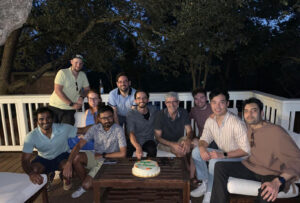On June 12, 2024 Hussein Alawieh successfully defended his Phd thesis:
“To Activate or Not to Activate? The Dual Role of Electrical Stimulation in Brain-Computer Interfaces”
Let’s Party!
We wish you all the best in your future career

Detailed Thesis Abstract:
Injuries affecting the central nervous system may disrupt the cortical pathways to muscles causing loss of motor control. Nevertheless, the brain still exhibits sensorimotor rhythms (SMRs) during movement intents, and brain-computer interfaces (BCIs) can decode SMRs to control assistive devices and promote functional recovery. Despite rapid advancements in BCI systems, a persistent challenge is the instability of SMR patterns due to the non-stationarity of neural signals. This may significantly degrade BCI performance over days and hamper the effectiveness of BCI-based rehabilitation. Subjects can learn to elicit reliable SMR and improve BCI control through longitudinal training, so a fundamental question is how to accelerate subject training building upon the SMR neurophysiology. Previous research has focused on combining EEG-BCIs with neuromodulation approaches that aim to increase SMR modulations via enhancing the excitability of sensorimotor networks with limited success. In this thesis, we explore new ways of using electrical stimulation to facilitate learning the necessary BCI control skills and to promote functional recovery in patients. In Part I of this thesis, we present evidence supporting a crucial role for cortical inhibition, facilitated by transcutaneous electrical spinal stimulation (TESS), in promoting the acquisition of SMR modulation skills. When used for conditioning the brain prior to BCI training, inhibitory neuromodulation with TESS constrains the neural dynamics and promotes focal and strong volitional SMR modulations. We support these findings by longitudinal BCI training data and neurophysiological correlates of performance gains for 25 healthy subjects over at least 6 sessions and for 2 individuals with tetraplegia after spinal cord injury (SCI) over a period of three weeks. We also provide a characterization of the inhibitory effects of TESS using somatosensory evoked potentials and paired pulse depression (SEP/PPD), and we link PPD-based evidence of cortical inhibition to physiological correlates of enhanced BCI performance.
In the second part of this thesis, we investigate complementing our proposed BCI training paradigm with peripheral electrical stimulation. It has been previously reported that sensory-threshold neuromuscular electrical stimulation (st-NMES) over peripheral muscles can provide natural somatosensory feedback contingent to MI; thus enhancing its kinesthetic experience and driving better BCI performance. To expand on the previous use of st-NMES, we first demonstrate its effectiveness in a new challenging scenario of controlling a BCI with MI of different gestures of the same hand. We hypothesized that st-NMES feedback helps users selectively activate adjacent cortical sources that generate MI patterns for different movements of the same limb. This results in easier classification of fine gestures from low spatial-resolution and non-invasive electroencephalogram (EEG) recordings. After establishing this, we propose coupling the two stimulation modalities, TESS and stNMES, into a single BCI paradigm for motor rehabilitation. We validate the efficacy of the latter intervention by providing evidence of functional gains accompanying successful BCI training for two patients with multiple sclerosis.
